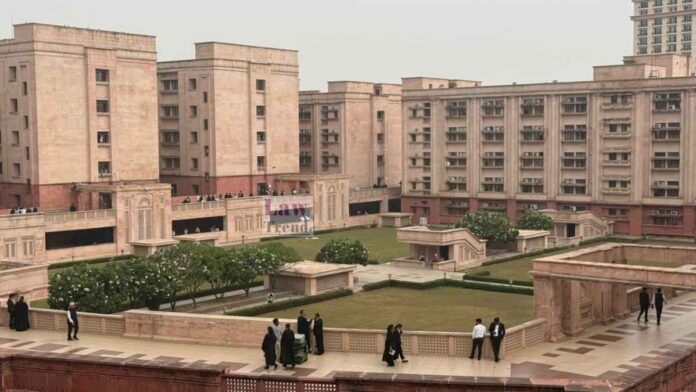The Allahabad High Court, Lucknow Bench, has suspended the life sentence of Rahul Verma, an I.I.T. Kanpur and I.I.M. Lucknow graduate convicted for a 2008 murder. The Division Bench of Justice Rajesh Singh Chauhan and Justice Abdhesh Kumar Chaudhary granted the suspension of sentence, pending appeal, citing prima facie weaknesses in the prosecution’s case, which was based entirely on circumstantial evidence and the “last seen theory.”
Case Background:
The appellant, Rahul Verma, filed Criminal Appeal No. 1790 of 2024 against the judgment and order dated 16.05.2024 and 22.05.2024, passed by the Special Judge, C.B.I., Court No.2, Lucknow. The trial court had convicted Verma in Sessions Trial No. 1900385 of 2012, arising from Crime No. RC 14(S) of 2010, for offences under Sections 302 (Murder) and 201 (Causing disappearance of evidence) of the I.P.C. He was sentenced to a maximum term of life imprisonment under Section 302 I.P.C. The trial court had, however, acquitted him of the offence under Section 364 I.P.C. (Kidnapping or abducting in order to murder).
The appeal order was issued on Criminal Misc. Bail Application No. 7 of 2024, which the court noted was effectively the first bail application being heard on its merits, as a previous application had been treated as short-term bail.
Arguments of the Appellant (Rahul Verma):
Shri Nandit Srivastava, learned Senior Advocate, assisted by Shri Rishad Murtaza, represented the appellant. Their arguments were as follows:
- The appellant, an I.I.T. Kanpur graduate, I.I.M. Lucknow postgraduate, and N.T.P.C. employee, was wrongfully convicted.
- The prosecution’s case was based “on the basis of untrustworthy circumstantial evidence and ‘last seen theory’,” with no direct eyewitnesses or medical evidence.
- They argued that the “chain of circumstances as mandated to be completed in view of the Judgment of the Supreme Court in the case of Sharad Birdhichand Sharda vs. State of Maharashtra… is apparently missing and the chain of events is incomplete.”
- The entire case revolved around the “dubious theory of an unreliable witness, namely, Vivek Kumar Trivedi (P.W.-19),” who was the sole witness for the ‘last seen theory’.
- Counsel highlighted delays fatal to the prosecution: the deceased, Adesh Bajpai, was missing from 10.08.2008; P.W.-19 informed the parents on 14.08.2008; the F.I.R. was lodged on 20.08.2008; and the affidavit from P.W.-19 implicating the appellant was given on 17.12.2009, over a year later.
- It was submitted that the ‘Test Identification Parade’ for the appellant was not conducted, despite P.W.-19 stating he could identify the person who met the victim.
- The identity of skeletal remains recovered from the I.I.T. Kanpur Campus was not proven to be the deceased’s, and no motive was established.
- The appellant’s acquittal under Section 364 I.P.C. “destroyed” the “entire genesis of the case.”
Arguments of the Respondent (C.B.I.):
Shri Anurag Kumar Singh, counsel for the C.B.I., vehemently opposed the suspension of sentence:
- The appellant committed the “heinous offence of Murder” of a young Fashion Designer, Adesh Bajpai.
- The victim went missing on 10.08.2008, and skeletal remains were recovered from the I.I.T. Kanpur Campus on 23.08.2008.
- The C.B.I. alleged that the victim and the appellant belonged to the “‘gay’ community” and knew each other through a website named “GuysNmen,” and were in touch on the night of 10.08.2008.
- The prosecution contended that scientific evidence, per an expert report dated 08.04.2011, proved the human skull and ante-mortem photographs were “likely to be of the same person,” identified as Adesh Bajpai.
- The C.B.I. argued that the ‘last seen theory’ and witness testimonies “remained unshaken and unchallenged” before the trial court.
High Court’s Analysis and Observations:
The High Court began by distinguishing between pre-trial bail (under Section 439 Cr.P.C.) and post-conviction suspension of sentence (under Section 389 Cr.P.C.). The court noted that post-conviction, the “presumption of innocence… fades in thin air.”
Citing the Supreme Court in Omprakash Sahni vs. Jai Shankar Chaudhary (2023) 6 SCC 123, the bench affirmed that suspension of sentence in a murder conviction is for “exceptional cases” and requires assessing if the convict has “fair chances of acquittal” based on “something palpable… very apparent or gross on the face of the record.”
The High Court then conducted a prima facie assessment of the two primary issues framed by the trial court:
- On the identity of the recovered bones: The High Court observed “a marked infirmity” in the trial court’s conclusion. It noted the evidence of P.W.-29 (Neeraj Rai), who stated he could not find adequate DNA from the bones as it was “‘degrate'” and that while MTDNA analysis matched the deceased’s mother, P.W.-29 admitted in cross-examination that MTDNA “could not be used as a conclusive proof” and was only for “supporting purpose.” Further, P.W.-32 (Dr. Sanjeev) stated the skull superimposing technique “cannot be applied with accuracy” as there was “no mandible” (lower jawbone). The High Court found the trial court’s conclusion was “not… based on scientific evidence brought on record.”
- On the ‘Last Seen Theory’: The High Court found that the trial court’s reasoning was substantially devoted to “trying to exonerate the P.W.-19, rather than discuss the evidence brought on record against the accused.” The court observed that the ‘last seen theory’ was “not… corroborated by any witnesses” and that the appellant was implicated based on P.W.-19’s delayed affidavit, a witness who “himself was under suspicion although out the investigation.”
The bench cited the Supreme Court judgment in Kanhaiya Lal vs. State of Rajasthan (2014) 4 SCC 715, which held: “The circumstance of last seen together does not by itself and necessarily lead to the inference that it was the accused who committed the crime. There must be something more establishing connectivity between the accused and the crime.”
The High Court concluded its prima facie analysis by stating, “the evidence of motive does not satisfy us to be an adverse circumstance against the appellant.” It added: “Primafacie, this Court finds that the appellant has been under suspicion solely because of him being a member of a community having a particular sexual orientation and the prosecution has sought to develop the said suspicion into a reality by weaving a chain incompatible with the evidence on record, which apparently have loose ends.”
Decision:
Finding merit in the appellant’s submissions, the High Court allowed the bail application and suspended the sentence dated 22.05.2024, pending the final hearing of the appeal.
The appellant, Rahul Verma, was ordered to be released on bail on furnishing a personal bond with two sureties, subject to conditions including: (i) Depositing the full fine amount within 30 days. (ii) Cooperating in the early disposal of the appeal. (iii) Not indulging in any criminal activity. (iv) Depositing his passport with the trial court and not leaving the country without permission.
The High Court has listed the appeal for final hearing in the third week of December 2025.







